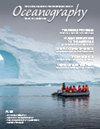Multi-Stressor Observations and Modeling to Build Understanding of and Resilience to the Coastal Impacts of Climate Change
IF 2.8
4区 地球科学
Q1 OCEANOGRAPHY
引用次数: 0
Abstract
Multiple stressors are affecting the Pacific Northwest (PNW) coastal ocean, including harmful algal blooms (HABs), ocean acidification, marine heatwaves, and hypoxia (low oxygen). While these conditions or events are tied to seasonal cycles such as upwelling periods and multiyear cycles such as El Niño/La Niña, they are becoming increasingly frequent and intense. Additionally, they can have devastating impacts on ecosystem health and human wellbeing, shutting down fisheries, stifling the local economy, threatening food security, and inhibiting cultural practices. For example, increasing ocean acidification has affected shellfish growers’ capability to secure reliable product. In 2015, a HAB associated with a marine heatwave shut down crab fisheries from Alaska to Baja for commercial and tribal fishers (McCabe et al., 2016), a closure so impactful that the US Congress included the Fishery Disaster Relief Program for Tribal Fisheries in the Budget Act of 2018. And, an unpredicted hypoxia event in 2015 resulted in the Quinault Indian Nation pulling up crab pots with dead crab. Regional projections indicate increases in warming, ocean acidification, and hypoxia by the end of the century (Siedlecki et al., 2021), so solutions are needed. The challenge of multi-stressor impacts can be addressed by engaging a variety of partners to collect multi-variable observing and forecast data while increasing both scientific knowledge and application of data and information to real-world needs. The Northwest Association of Networked Ocean Observing Systems (NANOOS, http://www.nanoos. org/) helps sustain long-term observations and forecast models to help communities adapt to and plan for variable and changing ocean conditions, thus increasing resilience. NANOOS is the PNW regional coastal ocean observing system of the US Integrated Ocean Observing System (IOOS). It was recently designated a nexus organization for the UN Decade of Ocean Science for Sustainable Development because of its work to sustain and integrate ocean observations and modeling to produce publicly accessible regional data products that help diverse coastal communities ensure safety, build economic resilience, and increase understanding of the coastal ocean. NANOOS, in collaboration with regional partners, provides observations of temperature, salinity, oxygen, chlorophyll, carbon dioxide, pH, and HABs from buoy assets off the PNW coast (Figure 1). These observations also support several models such as LiveOcean, which provides 72-hour projections of ocean variables such as temperature, salinity, Multi-Stressor Observations and Modeling to Build Understanding of and Resilience to the Coastal Impacts of Climate Change多压力源观测和建模以建立对气候变化对沿海影响的理解和恢复能力
多种压力因素正在影响太平洋西北海岸,包括有害藻华(HABs)、海洋酸化、海洋热浪和缺氧(低氧)。虽然这些条件或事件与季节性周期(如上升期)和多年周期(如El Niño/La Niña)有关,但它们正变得越来越频繁和强烈。此外,它们可能对生态系统健康和人类福祉产生破坏性影响,导致渔业关闭,扼杀当地经济,威胁粮食安全,并抑制文化习俗。例如,海洋酸化加剧影响了贝类养殖者获得可靠产品的能力。2015年,与海洋热浪相关的赤潮导致从阿拉斯加到巴哈的商业和部落渔民的螃蟹渔业关闭(McCabe等人,2016年),这一关闭的影响如此之大,以至于美国国会在2018年预算法中纳入了部落渔业渔业救灾计划。2015年,一场意想不到的缺氧事件导致奎诺特印第安人将蟹笼里的死蟹打捞出来。区域预估表明,到本世纪末,变暖、海洋酸化和缺氧将加剧(Siedlecki et al., 2021),因此需要解决方案。通过与各种合作伙伴合作,收集多变量观测和预测数据,同时增加科学知识,并将数据和信息应用于实际需求,可以解决多压力源影响的挑战。西北网络海洋观测系统协会(NANOOS, http://www.nanoos)。Org/)帮助维持长期观测和预测模型,以帮助社区适应和规划多变和不断变化的海洋条件,从而提高复原力。NANOOS是美国综合海洋观测系统(IOOS)的PNW区域沿海海洋观测系统。它最近被指定为联合国海洋科学促进可持续发展十年的联系组织,因为它致力于维持和整合海洋观测和建模,以生产可公开访问的区域数据产品,帮助不同的沿海社区确保安全,建立经济复原力,并增加对沿海海洋的了解。NANOOS与区域合作伙伴合作,提供PNW海岸浮标资产的温度、盐度、氧气、叶绿素、二氧化碳、pH值和有害藻华的观测数据(图1)。这些观测数据还支持LiveOcean等几个模型,该模型提供72小时海洋变量预测,如温度、盐度、多压力源观测和建模,以建立对气候变化对沿海影响的理解和恢复能力
本文章由计算机程序翻译,如有差异,请以英文原文为准。
求助全文
约1分钟内获得全文
求助全文
来源期刊

Oceanography
地学-海洋学
CiteScore
6.10
自引率
3.60%
发文量
39
审稿时长
6-12 weeks
期刊介绍:
First published in July 1988, Oceanography is the official magazine of The Oceanography Society. It contains peer-reviewed articles that chronicle all aspects of ocean science and its applications. In addition, Oceanography solicits and publishes news and information, meeting reports, hands-on laboratory exercises, career profiles, book reviews, and shorter, editor-reviewed articles that address public policy and education and how they are affected by science and technology. We encourage submission of short papers to the Breaking Waves section that describe novel approaches to multidisciplinary problems in ocean science.
 求助内容:
求助内容: 应助结果提醒方式:
应助结果提醒方式:


